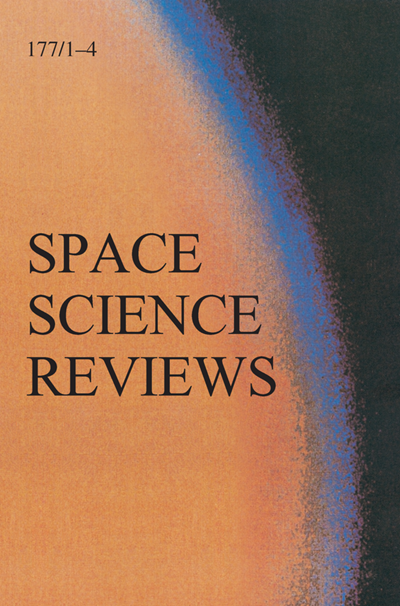Investigating Europa’s Radiation Environment with the Europa Clipper Radiation Monitor
IF 7.4
2区 物理与天体物理
Q1 ASTRONOMY & ASTROPHYSICS
引用次数: 0
Abstract
Abstract We present an overview of the radiation environment monitoring program planned for the Europa Clipper mission. The harsh radiation environment of Jupiter will be measured by a dedicated Radiation Monitor (RadMon) subsystem, yielding mission accumulative Total Ionizing Dose (TID) and instantaneous electron flux measurements with a 1-Hz cadence. The radiation monitoring subsystem is comprised of a stand alone sensor assembly along with distributed TID assemblies at various locations on the spacecraft. The sensor assembly itself is made of a TID sensor stack using the Metal-Oxide Semiconducting Field-Effect Transistor (MOSFET) and a Charge Rate Monitor (CRM) that uses a stack of bulk charge collection plates. The TID measurements will provide the critical information about the overall radiation levels relevant to the degradation of electronics over time, and the electron flux data can serve as a proxy for the Internal ElectroStatic Discharge (IESD) environment by measuring the >∼1 MeV electron environment. In addition, the radiation monitoring subsystem data will be augmented by serendipitous radiation data from science instruments onboard. This will be enabled by careful modeling and analysis of opportunistic background data from potentially the following instruments: Europa Imaging System (EIS), Europa-Ultraviolet Spectrograph (Europa-UVS), Mapping Imaging Spectrometer for Europa (MISE), MAss Spectrometer for Planetary EXploration (MASPEX), Plasma Instrument for Magnetic Sounding (PIMS), and SUrface Dust Analyzer (SUDA). Based on the current analysis, these instruments will be most sensitive to >1 MeV electrons. As such, the high-energy electron data obtained by the radiation monitoring subsystem will be qualitatively and quantitatively enhanced by the high-energy electron data acquired by the instruments. The holistic radiation monitoring program for the mission will be an extensive collaboration among many teams across the flight and payload systems. Although the radiation monitoring subsystem itself is an engineering resource for the mission, the collective data from the mission can also be used to improve the scientific understanding of the Jovian magnetosphere and the high-energy electron environment near Europa, where the motion of charged particles is perturbed by the local electromagnetic environment. The data could also help in the understanding of the radiation modification of Europa surface compounds, which could subsequently help guide lab experiments to aid in understanding the origin and evolution of surface materials and in constraining the interpretation of observational data. To this end, the radiation monitoring subsystem is a useful resource for helping address the Europa Clipper mission’s primary goal of assessing the habitability of Europa.用木卫二快船辐射监测器调查木卫二的辐射环境
摘要介绍了欧罗巴快船任务的辐射环境监测方案。木星的恶劣辐射环境将由专用的辐射监测仪(RadMon)子系统进行测量,产生任务累计总电离剂量(TID)和以1hz节奏进行的瞬时电子通量测量。辐射监测子系统由一个独立的传感器组件和分布在航天器上不同位置的TID组件组成。传感器组件本身由一个使用金属氧化物半导体场效应晶体管(MOSFET)的TID传感器堆栈和一个使用大量电荷收集板堆栈的充电率监视器(CRM)组成。TID测量将提供与电子设备随时间退化相关的总体辐射水平的关键信息,电子通量数据可以通过测量> ~ 1 MeV的电子环境作为内部静电放电(IESD)环境的代理。此外,辐射监测子系统的数据将通过机载科学仪器的偶然辐射数据得到增强。这将通过仔细建模和分析可能来自以下仪器的机会性背景数据来实现:木卫二成像系统(EIS)、木卫二紫外光谱仪(Europa- uvs)、木卫二测绘成像光谱仪(MISE)、行星探测质谱仪(MASPEX)、磁探测等离子体仪器(PIMS)和表面尘埃分析仪(SUDA)。根据目前的分析,这些仪器将对1兆电子伏的电子最敏感。因此,辐射监测分系统获得的高能电子数据将通过仪器获得的高能电子数据在定性和定量上得到提高。任务的整体辐射监测计划将是跨飞行和有效载荷系统的许多团队之间的广泛合作。虽然辐射监测子系统本身是该任务的工程资源,但该任务的集体数据也可用于提高对木星磁层和木卫二附近高能电子环境的科学认识,其中带电粒子的运动受到局部电磁环境的干扰。这些数据还有助于了解木卫二表面化合物的辐射修饰,从而有助于指导实验室实验,以帮助了解表面物质的起源和演化,并限制对观测数据的解释。为此,辐射监测子系统是一个有用的资源,可以帮助解决木卫二快船任务的主要目标,即评估木卫二的可居住性。
本文章由计算机程序翻译,如有差异,请以英文原文为准。
求助全文
约1分钟内获得全文
求助全文
来源期刊

Space Science Reviews
地学天文-天文与天体物理
CiteScore
19.70
自引率
3.90%
发文量
60
审稿时长
4-8 weeks
期刊介绍:
Space Science Reviews (SSRv) stands as an international journal dedicated to scientific space research, offering a contemporary synthesis across various branches of space exploration. Emphasizing scientific outcomes and instruments, SSRv spans astrophysics, physics of planetary systems, solar physics, and the physics of magnetospheres & interplanetary matter.
Beyond Topical Collections and invited Review Articles, Space Science Reviews welcomes unsolicited Review Articles and Special Communications. The latter encompass papers related to a prior topical volume/collection, report-type papers, or timely contributions addressing a robust combination of space science and technology. These papers succinctly summarize both the science and technology aspects of instruments or missions in a single publication.
 求助内容:
求助内容: 应助结果提醒方式:
应助结果提醒方式:


